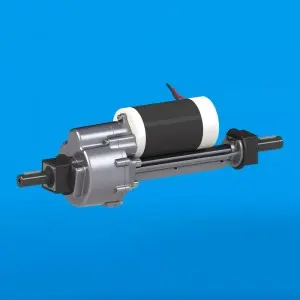If you own a riding lawn mower or small tractor, there’s a good chance you have a hydrostatic transaxle in your machine. This important component of the equipment is responsible for transmitting power from the engine to the wheels, allowing for smooth, precise movement. If you have problems with your hydrostatic transaxle, it’s important to understand how it works and how to operate it properly, including knowing how much the flywheel lever should move.
What is a hydrostatic transaxle?
A hydrostatic transaxle is a transmission that uses hydraulic pressure to transfer power from the engine to the wheels. Unlike a traditional transmission that uses gears, a hydrostatic transaxle uses a hydraulic pump and motor to control speed and direction. This allows for smooth, seamless operation without the need for gear changes.
The Importance of Flywheel Rods
The flywheel lever, also known as the bypass valve or idle bypass control, is an important feature of a hydrostatic transaxle. This lever allows the user to disconnect the transmission, which is useful for towing equipment or manually moving equipment without starting the engine. When the flywheel lever engages, the derailleur disengages, allowing the wheels to move freely.
How much should the flywheel lever move?
When operating a hydrostatic transaxle, it is important to know how much the flywheel lever should move. The flywheel lever should have a limited range of motion (usually about 1 inch) to disengage the transmission. Moving the flywheel lever too far may damage the transaxle, while moving it not far enough may prevent the wheels from moving freely.
Correct operation of flywheel lever
To operate the flywheel lever correctly, follow these steps:
1. Make sure the engine is off and the parking brake is engaged.
2. Locate the flywheel lever on the transaxle.
3. Gently move the flywheel lever to the disengaged position. The lever can only move about 1 inch from the engaged position.
4. Once the lever is in the disengaged position, the gearbox is bypassed, allowing the wheels to move freely.
Frequently Asked Questions about Flywheel Rods
If you are having problems with the flywheel lever on your hydrostatic transaxle, there are some common issues to be aware of:
1. The control lever moves too easily or too far: This may indicate wear or damage to the linkage or the control lever itself. Check for any loose or damaged parts and make necessary repairs or replacements.
2. Lever won’t move: If the flywheel control lever is stuck in the engaged position, it may be due to debris buildup or corrosion. Clean the area around the lever and lubricate the moving parts to help release the lever.
3. Wheels Not Moving Freely: If you have disengaged the transmission using the flywheel lever and the wheels still won’t move, there may be a problem with the transaxle itself. In this case it is best to consult a professional for further diagnosis and repair.
in conclusion
Understanding the function of a hydrostatic transaxle and knowing how to properly operate the flywheel lever are critical to maintaining the health and longevity of your equipment. By following the flywheel lever’s recommended range of motion and fixing any problems that arise, you can ensure smooth and efficient operation of your hydrostatic transaxle for years to come. If you experience any problems with your hydrostatic transaxle, seek professional help immediately to avoid further damage and expensive repairs.
Post time: Dec-27-2023


